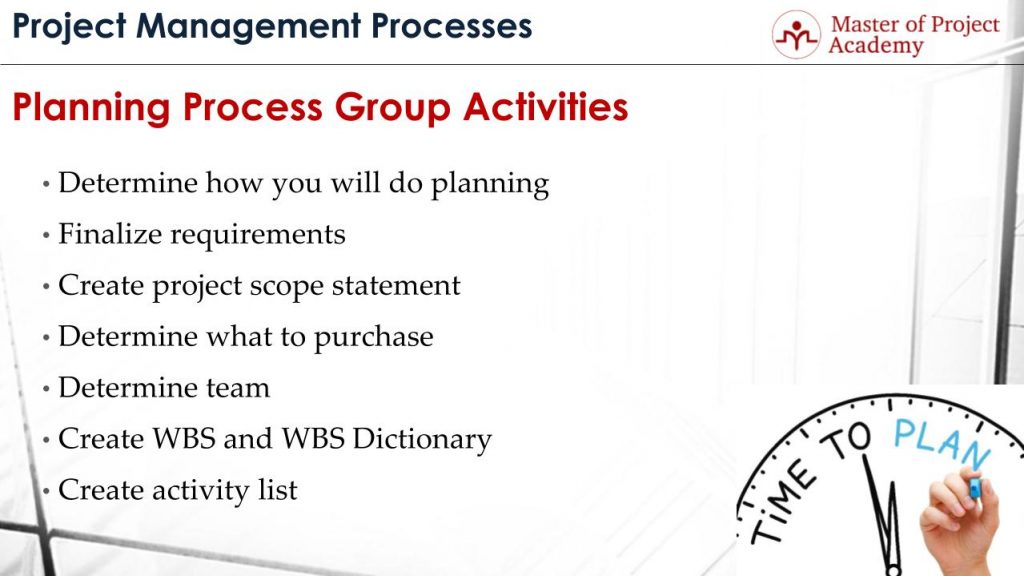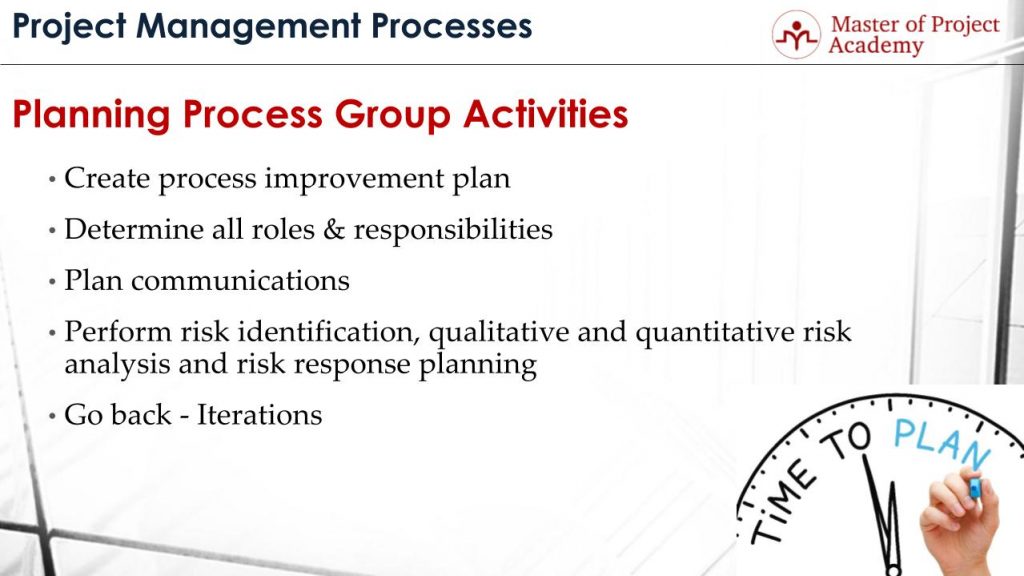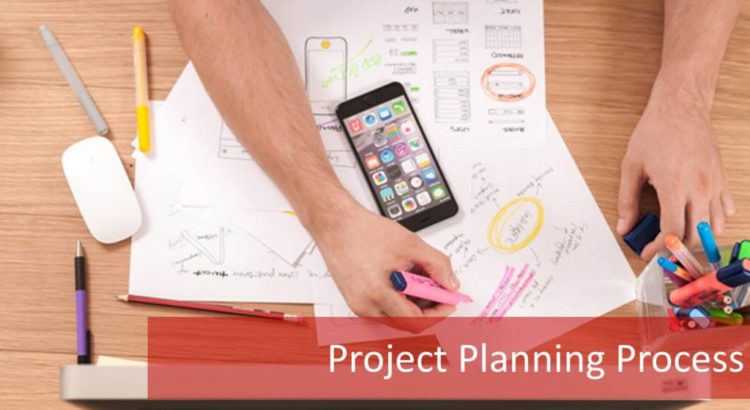In the project management, there are five process groups. The second one of these groups is project planning process. Project planning process comes after the project is initiated. This is the next step. A well-planned project has a higher chance of success. For this reason, this stage called the “project planning process” is crucial for the whole project lifecycle. So let’s begin to explore Planning Process Group Activities.
Attend our 100% Online & Self-Paced One-Hour Free PMP Training.
To obtain more knowledge about the process groups of a project you can check out our PMP Training.
Planning Process Group Activities: What Are the Activities in Project Planning Process Group?
The project planning process group activities help to create the planning documents of the project. You can find more detailed information about project management steps in the CAPM training.
Now let’s review the project planning process group activity steps one-by-one.

Planning Process Group Activities #1: Determine how you will do planning
The project planning process group activities define how you will approach project planning as well. They help to create a proper project planning.
Planning Process Group Activities #2: Finalize requirements
All of the project requirements, including scope, quality, cost, schedule etc. must be finalized in the beginning of planning. Because the overall project plan will be shaped based on the project requirements. If these requirements change, you will have to do a re-planning.
Note that, project management processes are documented and controlled by the help of project management templates. You can see sample free project management templates to have an idea of how they work.
Planning Process Group Activities #3: Create project scope statement
Project scope statement defines what will be done during the project. Also, what is included in the major deliverables and outputs of the project.
Project Planning Process Step #4: Determine what to purchase
During project planning process, a project manager must determine and plan the tools, equipments or any other resources which need to be purchased or leased. For instance, if there will be a construction project, steel, wood, tools for construction etc. must be purchased. Some vehicles might be required and they might be leased instead of purchased. All these resources must be planned in this process group.
Project Planning Process Step #5: Determine the team
During the planning phase, the project manager should determine the project resources that will be working throughout the project. For instance, how many software engineers will be working for the IT project? How many test engineers will be needed? These are all planned and determined during the planning process.
Project Planning Process Step #6: Create Work Breakdown Structure and Work Breakdown Strategy
Work breakdown structure is abbreviated as WBS. It actually depicts the hierarchy of project deliverables in a project. For instance, completion of a login page, credit card payment page, and transaction page can constitute a payment module work package of a website project. With several other work packages, a whole website can be completed. These kinds of hierarchies define the WBS. WBS dictionary is for giving detailed information for an item in the WBS.
Project Planning Process Step #7: Create activity list
The activities that must be completed for finishing a project are determined during project planning process. These activities must be as small as possible to assign a project team member. By this way, better management and coordination of the project can be ensured.

Project Planning Process Step #8: Create network diagram
This is another project planning process group activity. The network diagram of a project shows the interdependencies of project actives. Which activity must be finished before starting to another activity? Which activities have to be finished together? These kinds of interdependencies between the activities are defined in the Network diagram. For instance, before completing the software development of a web page, you cannot start the testing. So the testing activity must start once the software development activity finishes. These kinds of relationships are depicted in the network diagram.
Project Planning Process Step #9: Estimate resource requirements.
How many resources will be needed? Which tools and equipment that are required? What materials that will be used? These are all estimated during project planning process.
Project Planning Process Step #10: Estimate the time and cost
Projects are temporary endeavors. They should have a start and an end. Based on the scope and quality requirements of the project, the schedule and budget, required to complete this scope on determined schedule, are estimated.
Project Planning Process Step #11: Determine critical path
There are several activities of a project. Also, there are interdependencies between these activities. While some activities can be performed simultaneously, some other activities will depend on other activities to finish. After the interdependencies and duration of the activities are determined, the critical path of the project should be determined as well. The critical path of the project shows the longest path in the network diagram, from start of the project until the end. So it actually defines the total project duration.
Project Planning Process Step #12: Develop schedule
The schedule plan of a project shows which activity will start when. It also includes national holidays, annual leaves, public holidays etc. Schedule of a project includes start and end dates for each project activity.

Project Planning Process Step #13: Develop budget
The budget plan of a project shows how much money will be spent for what in a project. It includes the expected payment dates and amount of money that will be paid to the sellers, vendors or partners etc.
Project Planning Process Step #14: Determine quality, standards, procedures & metrics
What will be the quality objectives of the project? Are there any standards that the project must be compliant? For instance ISO 9001. What will be the procedures to follow? For instance, what are the steps for leasing a vehicle from a vendor? Or what is the outsourcing policy of the company? What will be the metrics? Will you use US standards or UK standards? These should be determined during the project planning process.

Project Planning Process Step #15: Create process improvement plan
Especially recurring processes needs to be improved throughout the project. Because there is always room for better doing an activity. How to improve the processes should be also planned continuously.
Project Planning Process Step #16: Determine all roles & responsibilities
Clear roles and responsibilities matrix is essential for the project success. This kind of a matrix will clearly show what is expected from who. It also clears out all ambiguities if there are any. Otherwise, assignments or activities that are not addressed clearly can cause conflicts and delays in the projects.
Project Planning Process Step #17: Plan communications
How will you communicate the project information with your stakeholders? For instance, a weekly report will be sent to project stakeholders in each 2 weeks. The executive directors will be informed through a 30 minutes meeting at the end of each month. How the information will be disseminated to who and when are planned during the project planning process.
Project Planning Process Step #18: Perform risk identification, qualitative and quantitative risk analysis and risk response planning
Project risks that are visible in the planning phase must be listed. These risks must be addressed with risk response strategies: It’s good for reducing the impact of these risks when they occur.
Project Planning Process Step #19: Go back-iterations
Project planning is iterative. Because an action or plan you did later, might eliminate the validity of a previous action or plan. Therefore, progressive planning and iterations are done to reach the most appropriate project planning in the end.

Planning Process Group Activities #20: Prepare procurement documents
If there will be tools, equipment, materials or resources that will be purchased from external organizations, how to purchase them from the vendors or suppliers must be documented. For instance, how will you select the supplier? What will be the conditions to make a payment to one of your suppliers, etc?
Planning Process Group Activities #21: Finalize “how to execute & control” parts of all management plans
At the end of the project planning process, the execution and monitoring & controlling approaches of the project must be concrete. And these plans must be implemented to reach the goals of the project in the end.
Planning Process Group Activities #22: Develop final PM plan and performance measurement baseline that are realistic
The final project plan must be completed by the end of the project planning process. This plan should include measurable objectives, attainable cost and schedule targets.
Planning Process Group Activities #23: Gain formal approval of the plan
This step is crucial. Once the project planning is completed, this plan must be approved by all project stakeholders. The project manager must be sure that everybody is on the same page about the project objectives and targets by the end of the planning phase. If there are disagreeing parties, these need to be clarified and revisions must be done. Otherwise, any party who does not believe in the created project plan or does not support the project plan brings a very high risk to the success of the project.
Project Planning Process Step #24: Hold kick-off meeting
The kick-off meeting is organized by the project manager, who invites the critical stakeholders to the meeting. The project plan is overviewed, project objectives, targets, and outcomes are summarized to the project stakeholders.
After the project planning process group activities are completed, the next the project management process group will be the Executing Process Group Activities.


6 thoughts on “24 Steps of Project Planning Process | What Are the Planning Process Group Activities”
Comments are closed.